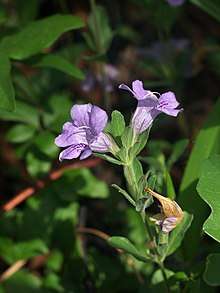Dyschoriste oblongifolia
Dyschoriste oblongifolia is a species of the genus Dyschoriste, in the family Acanthaceae. Dyschoriste oblongifolia is also called oblongleaf snakeherb or twinflower.
| Dyschoriste oblongifolia | |
|---|---|
 | |
| Scientific classification | |
| Kingdom: | Plantae |
| Clade: | Tracheophytes |
| Clade: | Angiosperms |
| Clade: | Eudicots |
| Clade: | Asterids |
| Order: | Lamiales |
| Family: | Acanthaceae |
| Genus: | Dyschoriste |
| Species: | D. oblongifolia |
| Binomial name | |
| Dyschoriste oblongifolia (Michx.) Kuntze | |
Description
Dyschoriste oblongifolia is a herbaceous, rhizomatous, perennial plant growing 10–50 cm (4–20 in) tall. Stems and foliage are mostly hairless. Leaves are arranged opposite, with an entire or undulate margin, an obtuse or acute tip, a cuneate or attenuate base, and a hairy surface. D. oblongifolia produces flowers that are subsessile and either solitary or clusters on the stem with bracts that appear similar to the leaves. The flowers often appear in pairs, hence the "Twinflower" name. Flowers are lavender in color, with five lobes, four stamens, and a style 1.5 cm long.[1] It grows in dry, sandy pine forests and flowers from June to August.[2]
Distribution
Dyschoriste oblongifolia grows natively in the United States in the coastal plains regions from Virginia to Florida,[3] but is able to grow throughout the southeastern US and along the western coast.[4]

Habitat, ecology, and usage
Dyschoriste oblongifolia is a tolerant plant that can grow in acidic or slightly alkaline soil of sand, loam, or clay. It has high drought tolerance and low salt tolerance.[4] Wildfire is a key part of the plant's life cycle. Populations will disappear over time if fire does not occur.[5]
Gardeners sometimes plant Dyschoriste oblongifolia in their butterfly gardens as a larval host plant for the common buckeye butterfly,[6] and the plant is a recommended ornamental groundcover due to its high drought tolerance and low maintenance requirements.[7]
References
- Radford, Albert E.; Ahles, Harry E.; Bell, C. Ritchie (1968). Manual of the Vascular Flora of the Carolinas. North Carolina: The University of North Carolina Press. p. 971.
- Chapman, A. W. (1897). Flora of the Southern United States (3 ed.). New York: American Book Company. p. 365.
- Gleason, Henry A. (1968). Illustrated Flora of the Northeastern United States and Adjacent Canada. New York: Hafner Publishing Company. p. 266.
- Gilman, Edward. "Dyschoriste oblongifolia Twinflower". Institute of Food and Agricultural Sciences. University of Florida. Retrieved 4 April 2019.
- Hammer, Roger L. (2018). Complete Guide to Florida Wildflowers. Rowman & Littlefield. p. 13. ISBN 9781493030941.
- Hammer, Roger L. (2015). Everglades Wildflowers. Rowman & Littlefield. p. 14. ISBN 9781493014590.
- Haynes, Jody; Hunsberger, Adrian; McLaughlin, John; Vasquez, Laura (2015). "Drought-tolerant, low-maintenance for south "Florida Yards" and "Florida Landscapes"". Institute of Food and Agricultural Sciences: 6.